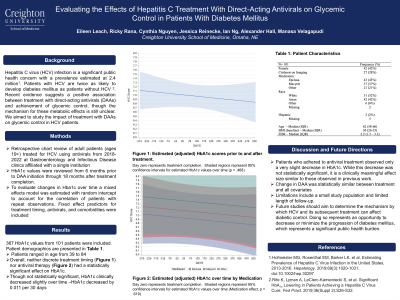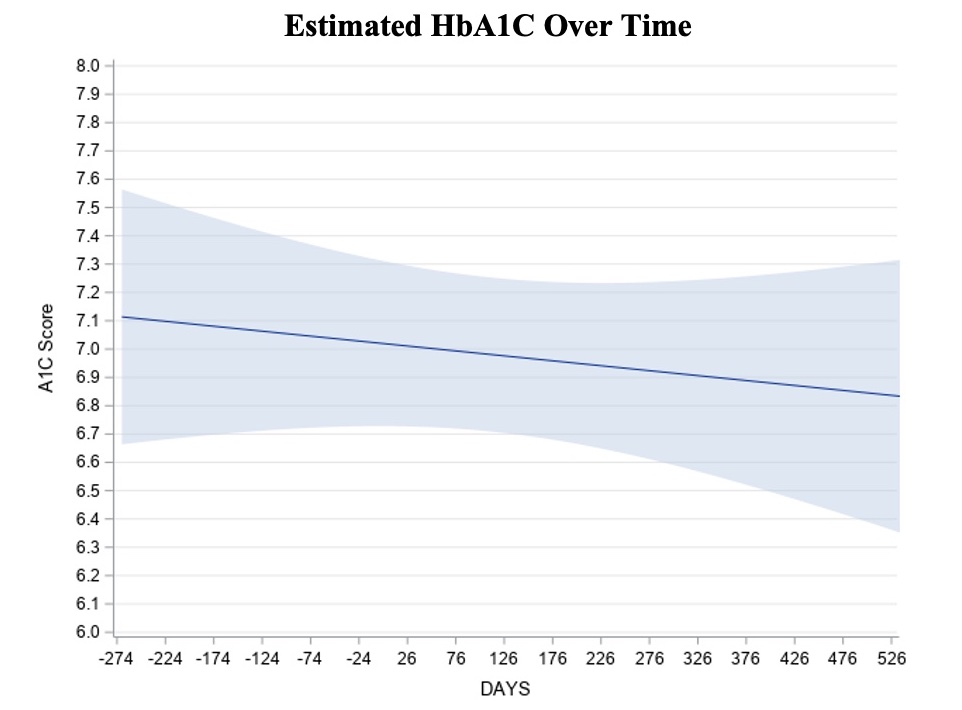Sunday Poster Session
Category: Liver
P1227 - Evaluating the Effects of Hepatitis C Treatment With Direct-Acting Antivirals on Glycemic Control in Patients With Diabetes Mellitus
Sunday, October 27, 2024
3:30 PM - 7:00 PM ET
Location: Exhibit Hall E

Has Audio
- EL
Eileen Leach, BS
Creighton University School of Medicine
Omaha, NE
Presenting Author(s)
Eileen Leach, BS1, Ricky Rana, BS2, Manasa Velagapudi, MBBS3, Ian Ng, MPH4, Alexander Hall, MS1, Cynthia Nguyen, 5, Jessica Reinecke, BS1
1Creighton University School of Medicine, Omaha, NE; 2Creighton University School of Medicine, Sugar Land, TX; 3Creighton University Medical Center, Omaha, NE; 4Creighton University, Omaha, NE; 5Creighton University School of Medicine, Phoenix, AZ
Introduction: Patients with chronic Hepatitis C virus (HCV ) are about twice as likely to develop diabetes compared to those without HCV. Direct-acting antiviral (DAA) medications have improved HCV management, but recent evidence suggests potential associations between DAA therapy and glycemic control, raising questions about its metabolic effects. While the mechanisms underlying these effects are not fully known, data suggests a link between DAA use and improvement of glycemic control . This study used retrospective chart review to assess the impact of antiviral treatment for Hepatitis C on patients' glycemic control.
Methods: Adult (19+) patients with HCV infection and Type 2 Diabetes who were treated in Gastroenterology and Infectious Diseases clinics at a single institution from 2018-2022 were included. Pre and post HCV treatment HbA1c values were reviewed from 6 months prior to treatment initiation, through 18 months post treatment completion. To evaluate changes in Hba1c over time a mixed effects model was estimated with random intercept to account for the correlation of patients with repeat observations. Additionally, fixed effect predictors for treatment timing, (pre/during/post) Hep C antivirals (Mavyret vs Epclusa vs other) and comorbidities (sex, baseline BMI, age, FIB4, and cirrhosis on imaging) were included.
Results: A total of 367 HbA1c observations from 101 patients were included (median 3, Interquartile 2-5). Baseline characteristics of the study population as in table 1; patients were primarily white (51.5%) or Asian (42.4%) males (57.6%) between ages 39-84 without cirrhosis (71.9%). Overall, neither discrete treatment timing (p=.509) nor antiviral therapy used (p=.619) had a statistically significant effect on HbA1c. Clinically, HbA1c decreased slightly over time – for every 30 days, model adjusted HbA1c decreased by 0.011% (p = .468, figure 1).
Discussion: Patients who adhered to antiviral treatment observed only a very slight decrease in HbA1c . While this decrease was not statistically significant, it is similar in effect size to previous work and may represent a clinically meaningful decrease.

Note: The table for this abstract can be viewed in the ePoster Gallery section of the ACG 2024 ePoster Site or in The American Journal of Gastroenterology's abstract supplement issue, both of which will be available starting October 27, 2024.
Disclosures:
Eileen Leach, BS1, Ricky Rana, BS2, Manasa Velagapudi, MBBS3, Ian Ng, MPH4, Alexander Hall, MS1, Cynthia Nguyen, 5, Jessica Reinecke, BS1. P1227 - Evaluating the Effects of Hepatitis C Treatment With Direct-Acting Antivirals on Glycemic Control in Patients With Diabetes Mellitus, ACG 2024 Annual Scientific Meeting Abstracts. Philadelphia, PA: American College of Gastroenterology.
1Creighton University School of Medicine, Omaha, NE; 2Creighton University School of Medicine, Sugar Land, TX; 3Creighton University Medical Center, Omaha, NE; 4Creighton University, Omaha, NE; 5Creighton University School of Medicine, Phoenix, AZ
Introduction: Patients with chronic Hepatitis C virus (HCV ) are about twice as likely to develop diabetes compared to those without HCV. Direct-acting antiviral (DAA) medications have improved HCV management, but recent evidence suggests potential associations between DAA therapy and glycemic control, raising questions about its metabolic effects. While the mechanisms underlying these effects are not fully known, data suggests a link between DAA use and improvement of glycemic control . This study used retrospective chart review to assess the impact of antiviral treatment for Hepatitis C on patients' glycemic control.
Methods: Adult (19+) patients with HCV infection and Type 2 Diabetes who were treated in Gastroenterology and Infectious Diseases clinics at a single institution from 2018-2022 were included. Pre and post HCV treatment HbA1c values were reviewed from 6 months prior to treatment initiation, through 18 months post treatment completion. To evaluate changes in Hba1c over time a mixed effects model was estimated with random intercept to account for the correlation of patients with repeat observations. Additionally, fixed effect predictors for treatment timing, (pre/during/post) Hep C antivirals (Mavyret vs Epclusa vs other) and comorbidities (sex, baseline BMI, age, FIB4, and cirrhosis on imaging) were included.
Results: A total of 367 HbA1c observations from 101 patients were included (median 3, Interquartile 2-5). Baseline characteristics of the study population as in table 1; patients were primarily white (51.5%) or Asian (42.4%) males (57.6%) between ages 39-84 without cirrhosis (71.9%). Overall, neither discrete treatment timing (p=.509) nor antiviral therapy used (p=.619) had a statistically significant effect on HbA1c. Clinically, HbA1c decreased slightly over time – for every 30 days, model adjusted HbA1c decreased by 0.011% (p = .468, figure 1).
Discussion: Patients who adhered to antiviral treatment observed only a very slight decrease in HbA1c . While this decrease was not statistically significant, it is similar in effect size to previous work and may represent a clinically meaningful decrease.

Figure: Day zero represents treatment completion. Shaded regions represent 95% confidence intervals for estimated HbA1c values over time (p = .468)
Note: The table for this abstract can be viewed in the ePoster Gallery section of the ACG 2024 ePoster Site or in The American Journal of Gastroenterology's abstract supplement issue, both of which will be available starting October 27, 2024.
Disclosures:
Eileen Leach indicated no relevant financial relationships.
Ricky Rana indicated no relevant financial relationships.
Manasa Velagapudi indicated no relevant financial relationships.
Ian Ng indicated no relevant financial relationships.
Alexander Hall indicated no relevant financial relationships.
Cynthia Nguyen indicated no relevant financial relationships.
Jessica Reinecke indicated no relevant financial relationships.
Eileen Leach, BS1, Ricky Rana, BS2, Manasa Velagapudi, MBBS3, Ian Ng, MPH4, Alexander Hall, MS1, Cynthia Nguyen, 5, Jessica Reinecke, BS1. P1227 - Evaluating the Effects of Hepatitis C Treatment With Direct-Acting Antivirals on Glycemic Control in Patients With Diabetes Mellitus, ACG 2024 Annual Scientific Meeting Abstracts. Philadelphia, PA: American College of Gastroenterology.
